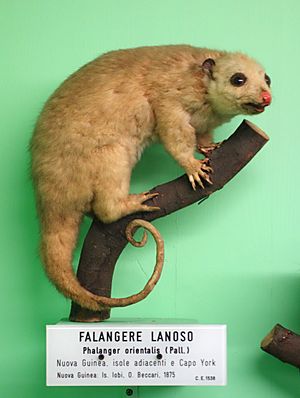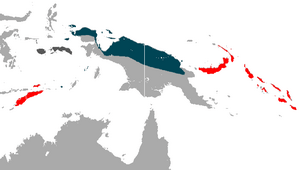Northern common cuscus facts for kids
The northern common cuscus (Phalanger orientalis), also called the grey cuscus, is a type of marsupial. It belongs to the family Phalangeridae. This animal originally lived in northern New Guinea and nearby small islands.
Over time, it was also found in other places. These include the Bismarck Archipelago, parts of the Moluccas, the Solomons, and Timor. Scientists believe it was brought to these new areas long ago, even before recorded history, from New Guinea.
People in New Guinea sometimes hunt the northern common cuscus for food.
Quick facts for kids Northern common cuscus |
|
|---|---|
 |
|
| Conservation status | |
| Scientific classification | |
| Genus: |
Phalanger
|
| Species: |
orientalis
|
 |
|
| Northern common cuscus range (blue — native, red — introduced, dark gray — origin uncertain) |
|
Contents
What is a Northern Common Cuscus?
The northern common cuscus is a small, furry animal. It is a marsupial, which means the mother carries her babies in a pouch, like a kangaroo. It is also known as the grey cuscus because of its fur color.
Where Does the Cuscus Live?
The northern common cuscus likes to live in places where the natural environment has been changed. This includes forests that are growing back, farms, and gardens. You can also find them in untouched tropical forests. Local hunters think these animals prefer to sleep in hollow parts of trees.
This cuscus lives on many islands. These include Timor (in Indonesia and Timor-Leste), Wetar, and Leti. It is also found in the Kai Islands and several Moluccan Islands in Indonesia, like Ambon, Buru, and Seram. You can see them on Misool, Waigeo, Batanta, and Salawati islands too.
The northern common cuscus also lives across much of northern New Guinea. This includes both the Indonesian and Papua New Guinean parts. It can be found on many islands in the Bismarck Archipelago, such as New Britain and New Ireland. It also lives on many of the Solomon Islands.
Scientists believe that the cuscus was brought to many of these islands by people a very long time ago. This might include Timor, Seram, Buru, and the Solomon Islands. People living in these areas say the cuscus can be found in any forest, from coastal rainforests to mountain forests.
For example, the northern common cuscus was brought to New Ireland between 10,000 and 20,000 years ago. It arrived in the Solomon Islands after 6,000 years ago. It is also an introduced species on Biak Island and Supiori Island.
What Does the Cuscus Eat?
The northern common cuscus is mostly active at night. It spends its time in trees. It mainly eats leaves, but it also enjoys eating fruits. This makes it a folivore (leaf-eater) with some frugivorous (fruit-eating) habits.
See also
 In Spanish: Cuscús gris para niños
In Spanish: Cuscús gris para niños


